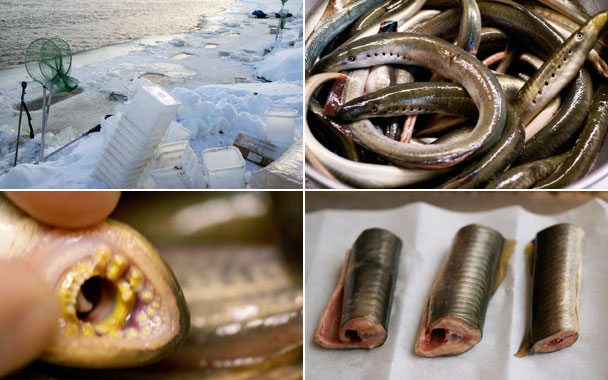As a marketing guy always up for an interesting challenge, I jumped at the chance to help develop markets for an experimental commercial fishery for Arctic lamprey on the Alaska’s lower Yukon River, where the average income is only $7,000 per year. “Lamprey….what is that ?” was the first response I got. My work was cut out.
Boneless, parasitic lampreys are living fossils. Often mistaken for eels, the primitive creatures spend a number of years as eyeless juveniles buried in the river bottom, filter-feeding. As they grow into adults, they develop eyes and a sucking mouth with rasping teeth, and head out to sea to glom onto whatever they can, including prized Yukon king salmon. The flavor of lamprey is rich and sweet, not unlike large fresh sardines.
Lamprey were once common in the cuisines of most European countries, but European lampreys in many areas have succumbed to over-harvesting, dams, and pollution and are either extinct or protected. In the United States, dwindling native lamprey populations are protected in Washington, Oregon, and California (though the fish has become a much-loathed invasive species in the Great Lakes). Alaska’s Department of Fish and Game, however, is experimenting with sustainable fishery management for lamprey; it allowed 40,000 pounds of the fish to be taken from the Yukon river in 2007. I headed up to take part in the harvest and see the fishery for myself.
My client hoped for a late-November harvest in Grayling, a Native American village (population: 185) 400 miles upriver. It took two bush planes to get there from Anchorage. A snow machine pulling a dog sled served as an airport taxi.
A seven-mile ride downriver in a snow machine took me to the fishing spot, a cutbank where the Yukon narrows and runs more swiftly. Two trappers’ cabins with wood stoves are pitched on the river bank, places for fishermen to have a cup of coffee and BS each other. Lamprey come all at once in a huge swarm. The run can pass by in a matter of hours, so someone has to be on the ice at all times to alert the village by radio if they show. A missed run is a substantial lost income opportunity for the village. Lamprey fishing involves lots of coffee: The wait can be days, sometimes weeks.
When lamprey are expected, tradition has it that women don’t go on the ice. The same for anyone from a family which has had a death within the past year. Everyone could remember a year when the “eels” didn’t show and why. Maureen Horne-Brine, the Alaska Department of Fish and Game representative in Grayling to monitor the harvest, respectfully kept her distance from the ice.
A total of 42 pounds were caught while I was there—peanuts compared to the expected main run. But I had to return to Seattle, so I took back half the catch, still alive, in a 5 gallon salmon roe bucket to dole out to a few chefs there.
Joseba Jimenez de Jimenez, chef-owner of Harvest Vine, was the most enthusiastic recipient. Excited even. He grew up eating and cooking lampreys in the Basque part of Spain, and he said they reminded him of home. He offered lamprey pie on this menu and reports it was well received.
Unfortunatley, I couldn’t follow up with more product, but I had a number of chefs around the country waiting for shipments. The big numbers of lamprey never showed up in Grayling. The total catch for the season was those 42 pounds—this in comparison to some 30,000 pounds taken in just a few hours two years ago. What happened to the run? The elders offer several possible explanations. The school went by in the middle of the river or on the opposite shore. Or perhaps they went by the day the winds blew 60 mph and fishermen couldn’t get out on the ice.
Or maybe someone had a death in the family, or there had been a woman on the ice.
As a former fisherman myself, I’m already anticipating the next season’s bounty, hoping to help make the Yukon Arctic lamprey the next “new fish.”




 Pinterest
Pinterest


